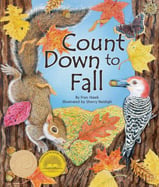Alignment to Standards for NH

| Grade | Number | Standard |
|---|---|---|
| 2 | S:ESS1:2:1.1 | weather conditions change frequently, and that weather patterns change over the seasons. |
| 2 | S:LS1:2:1.2 | plants and animals as living things and describe how they are alike and different. |
| 2 | S:LS1:2:2.1 | plants and animals have features that help them survive in different environments. |
| 2 | S:LS2:2:1.3 | Recognize that some plants and animals go through changes in appearance when the seasons change. |
| 2 | S:LS2:2:2.1 | Identify the resources plants and animals need for growth and energy, and describe how their habitat provides these basic needs. |
| 2 | S:LS3:2:3.1 | similarities and differences in both behavior and appearance of plants and animals. |
| 2 | S:LS3:2:3.2 | there are different species of living things in various places around the world. |
| 2 | S:LS5:2:1.1 | Recognize that new products can be made out of natural materials, such as paper from trees and cloth from various plants and animals. |
| 2 | S:PS1:2:2.1 | Identify the observable properties of different objects, such as color, size, shape, weight and texture. |
| 2 | S:SPS1:2:1.5 | Sort and classify object materials and events based on one or more attributes; and explain the methods used for sorting. |
| 2 | S:SPS1:2:4.2 | Identify and describe patterns and relationships in observed objects and events. |
| 2 | SS:EC:2:5.1 | Define the term resources, e.g., trees, books |
| 2 | SS:GE:2:3.1 | Earth-Sun relationship affects our daily lives, e.g., seasons in New Hampshire or sunlight and shadows. |
| 2 | SS:GE:2:3.2 | components and distribution of ecosystems, e.g., desert or rain forest. |
| 2 | SS:GE:2:4.2 | Identify what are natural resources, e.g., water or trees. |
| 2 | SS:GE:2:5.1 | role of natural resources in daily life, e.g., food, clothing, or shelter. |
| 2 | SS:GE:2:5.2 | how people use resources, e.g., building homes or the food they eat. |
| 4 | S:LS1:4.2.2 | function of the plant structures responsible for food production, water transport, support, reproduction, growth and protection. |
| 4 | S:LS1:4:1.2 | Sort/classify different living things using similar and different characteristics; and describe why organisms belong to each group or cite evidence about how they are alike or not alike. |
| 4 | S:LS1:4:2.1 | living organisms have certain structures and systems that perform specific functions, facilitating survival, growth and reproduction. |
| 4 | S:LS1:4:2.3 | physical structures of an organism (plants or animals) allow it to survive in its habitat/environment |
| 4 | S:LS1:4:3.1 | plant and animal characteristics that are inherited, such as eye color in humans and the shape of leaves in plants, and those that are affected by their environment, such as grass turning brown due to lack of water. |
| 4 | S:LS1:4:3.3 | reproductive process of plants, explaining some plants grow from seed, while others grow from the parts of other plants. |
| 4 | S:LS2:4:1.1 | Describe how the nature of an organismês environment, such as the availability of a food source, the quantity and variety of other species present, and the physical characteristics of the environment affect the organismês patterns of behavior. |
| 4 | S:LS2:4:2.2 | energy is needed for all organisms to stay alive and grow or identify where a plant or animal gets its energy. |
| 4 | S:LS2:4:3.1 | plants and animals interact with one another in various ways besides providing food, such as seed dispersal or pollination. |
| 4 | S:LS2:4:3.2 | Describe ways plants and animals depend on each other (e.g., shelter, nesting, food). |
| 4 | S:LS3:4:1.3 | changes in the environment can cause organisms to respond (survive there and reproduce, move away, die). |
| 4 | S:LS3:4:3.1 | individuals of the same species differ in their characteristics; and explain that sometimes these differences give individuals an advantage in survival and reproduction. |
| 4 | S:LS3:4:3.2 | for any particular environment, some kinds of animals and plants survive well, some less well, and some cannot survive at all. |
| 4 | S:SPS3:4:2.6 | Organize information to search for relationships and patterns concerning the environment and environmental topics. |
| 4 | SS:GE:4:5.4 | role of natural resources in daily life, e.g., food, clothing, or shelter. |